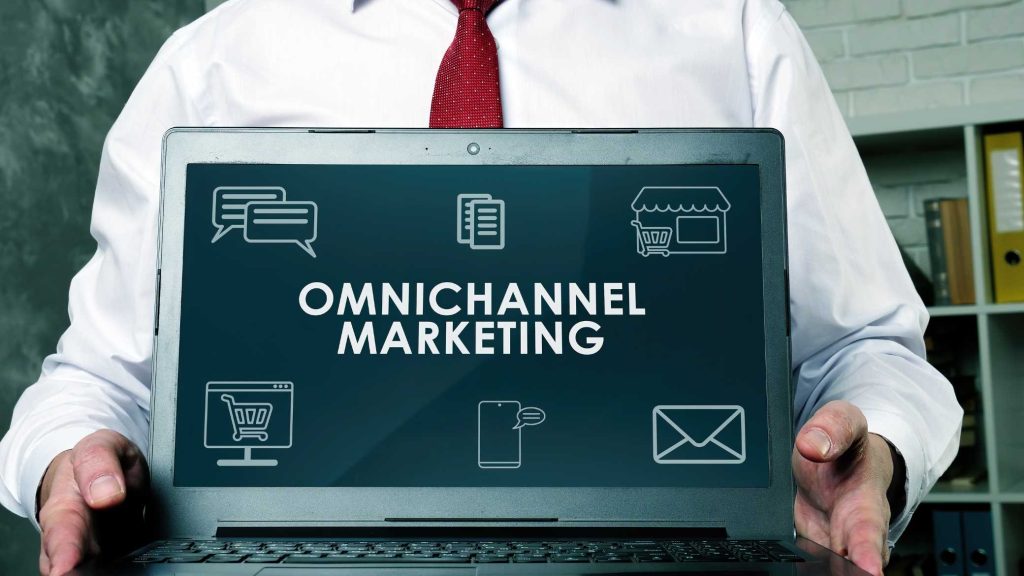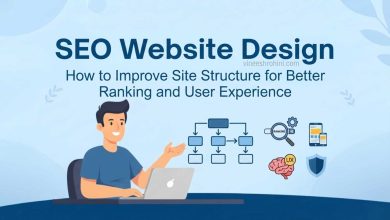Omnichannel Marketing in 2025 – A Comprehensive Guide
Omnichannel Marketing : In the ever-evolving landscape of digital marketing, the customer journey has become increasingly complex. With the rise of multiple digital platforms, online marketplaces, social media networks, and offline retail touchpoints, businesses must now ensure that customers enjoy a consistent, personalized, and seamless experience across all channels. This is where omnichannel marketing stands out as one of the most powerful strategies for 2025 and beyond.
Table of Contents
As consumer behavior becomes more dynamic and expectations rise, businesses that can integrate technology, creativity, and data-driven insights to deliver unified experiences will thrive. In this comprehensive guide, we’ll explore everything about omnichannel marketing—what it is, why it matters, how it differs from multichannel marketing, how to implement it effectively, and what trends will shape its future.
Understanding Omnichannel Marketing

Omnichannel marketing refers to a fully integrated approach to marketing, sales, and customer service that unifies all channels—both digital and physical—into one seamless brand experience. It ensures that whether a customer interacts with your business through a website, mobile app, email, social media, in-store visit, or even voice assistant, the experience remains consistent and connected.
The essence of omnichannel marketing lies in customer continuity. For instance, imagine a customer browsing shoes on your eCommerce app, adding a pair to their cart, and then receiving a personalized email reminding them of the same product later. When they finally visit your physical store, the sales associate already knows about the online interest and offers a discount to close the sale. This unified experience across platforms defines a true omnichannel journey.
In 2025, omnichannel marketing isn’t just a competitive advantage—it’s a business necessity. Customers expect personalization, speed, and consistency, and they reward brands that can deliver these across all touchpoints.
Omnichannel vs. Multichannel Marketing
It’s easy to confuse omnichannel and multichannel marketing, but the distinction is crucial.
- Multichannel marketing involves using multiple channels like websites, social media, and email independently. Each channel works in isolation with its own strategy and goals.
- Omnichannel marketing, on the other hand, integrates all channels to deliver a connected experience. The focus is not on the number of channels used but how effectively they communicate with one another.
Also Read : Digital Marketing for Personal Brands : Comprehensive Guide 2025
For example, in a multichannel approach, your FB ad campaign may not reflect a customer’s previous website interaction. But in an omnichannel setup, the system recognizes that the customer visited the site, viewed a product, and then tailors the FB ad to show that exact product with a personalized offer.
This interconnectedness and real-time synchronization are what make omnichannel strategies far superior in driving engagement and conversions.
Why Omnichannel Marketing Matters in 2025

As of 2025, digital users are more connected than ever. The average consumer interacts with a brand across 6 to 8 touchpoints before making a purchase. Whether it’s watching product videos, reading reviews, or engaging in live chat, each touchpoint influences the buying decision.
Here’s why omnichannel marketing has become essential:
- Enhanced Customer Experience: A consistent experience across channels builds trust and keeps customers coming back.
- Increased Conversions: When the customer journey is frictionless, conversion rates naturally rise.
- Higher Customer Retention: Satisfied customers who feel understood are more likely to become loyal advocates.
- Improved Data Insights: Integrating data across platforms helps brands make smarter decisions and deliver better personalization.
- Competitive Advantage: Brands that master omnichannel strategies differentiate themselves from competitors stuck in outdated siloed systems.
In 2025, customer loyalty isn’t just about product quality—it’s about how effortlessly and intelligently a brand can connect across platforms.
Core Pillars of Omnichannel Success
To implement a successful omnichannel marketing strategy, businesses need to focus on several foundational pillars.
1. Customer Understanding and Segmentation
Everything begins with knowing your customer. Use analytics tools, surveys, and purchase data to segment audiences based on preferences, behaviors, and pain points. This allows personalized marketing and better product recommendations.
2. Unified Brand Messaging
Consistency builds recognition. Your tone, design, and communication style should remain uniform across websites, emails, apps, and in-store displays. A unified brand message strengthens identity and fosters trust.
3. Technology Integration
Invest in Customer Relationship Management (CRM) and Customer Data Platforms (CDPs) to centralize data. These tools connect every interaction—be it through chat, email, or purchases—into one customer profile, enabling real-time personalization.
4. Seamless Channel Integration
Omnichannel marketing thrives when every channel complements the other. A customer who interacts via Insta should have their journey reflected in your email or mobile app automatically.
5. Data-Driven Personalization
Data is the backbone of personalization. Leverage AI-driven insights to deliver product recommendations, offers, and content tailored to each user’s journey.
6. Automation and Retargeting
Automate repetitive marketing processes such as email follow-ups, abandoned cart reminders, and retargeting ads. Automation ensures no customer is lost between touchpoints.
7. Performance Analytics
Measure success through KPIs like engagement rate, conversion rate, and customer lifetime value (CLV). Regularly analyze this data to refine your omnichannel strategy for maximum ROI.
Omnichannel Marketing Channels in 2025
Omnichannel marketing doesn’t mean using every channel; it’s about connecting the right ones effectively. Here are the most impactful channels in 2025:
1. Websites and Mobile Apps
Your digital storefront must be optimized for speed, usability, and responsiveness. In 2025, many brands are adopting Progressive Web Apps (PWAs) that blend web and app experiences for seamless interaction.
2. Social Media Platforms
Social platforms like Insta, YT, and LinkedIn are essential for brand discovery. Integrate shoppable posts, AI-driven ads, and interactive features to connect directly with your audience.
3. Email and SMS Marketing
Despite the rise of new communication tools, email and SMS remain high-conversion channels. Personalized newsletters, order updates, and flash sale messages keep customers engaged.
4. Search Engines
SEO and SEM campaigns should be integrated into your omnichannel plan. Ensure your organic and paid strategies align to reinforce brand authority.
5. Offline and Retail Channels
Physical stores still matter in 2025, especially when linked with digital channels. Features like QR code scanning, mobile payments, and digital receipts bridge the gap between online and offline experiences.
6. Voice Search and AI Assistants
With more consumers using smart speakers and mobile voice assistants, optimizing for voice queries ensures better reach and accessibility.
Developing a Winning Omnichannel Strategy
Creating an omnichannel marketing plan involves several deliberate steps:
Step 1: Map the Customer Journey
Understand how customers discover, engage, and purchase. Identify pain points where customers drop off and design smoother transitions between channels.
Step 2: Centralize Data
Integrate all touchpoints into a single data system. A unified customer view enables accurate targeting and messaging.
Step 3: Create Consistent Content
Maintain a consistent tone, look, and message across all platforms. Whether a customer reads a blog or visits your store, they should instantly recognize your brand.
Step 4: Personalize Every Interaction
Use predictive analytics to deliver dynamic content, personalized recommendations, and timely offers.
Step 5: Optimize for Mobile
With mobile users dominating online activity, ensure all digital assets — websites, emails, ads, and apps — are mobile-friendly and responsive.
Step 6: Test and Analyze
Regularly A/B test campaigns and track customer responses. Use insights to improve efficiency and relevance.
Best Practices and Tips for Omnichannel Success in 2025

- Use AI for Predictive Insights: Machine learning algorithms can anticipate customer needs and behaviors.
- Implement Real-Time Tracking: Monitor how customers move between channels in real time to adjust marketing actions instantly.
- Leverage Marketing Automation: Tools like HubSpot and Salesforce can automate workflows and nurture leads efficiently.
- Focus on Retargeting: Use retargeting ads to re-engage customers who showed interest but didn’t convert.
- Enable Seamless Payments: Support multiple payment gateways for convenience and flexibility.
- Encourage Omnichannel Loyalty Programs: Reward customers for engaging across channels with exclusive benefits.
- Adopt Cloud-Based Solutions: Cloud platforms make integration between CRM, analytics, and eCommerce faster and more secure.
- Train Your Team: Equip your marketing and sales teams with the knowledge and tools to deliver consistent omnichannel service.
Challenges of Omnichannel Marketing
While omnichannel marketing offers impressive rewards, it comes with challenges:
- Data Fragmentation: Integrating multiple systems can be complex and time-consuming.
- Cost of Implementation: Small businesses may struggle with initial setup costs.
- Maintaining Consistency: Ensuring every channel aligns with brand voice is challenging at scale.
- Privacy and Compliance: Managing customer data while adhering to global privacy regulations requires diligence.
Businesses that address these challenges early on will achieve smoother execution and stronger customer loyalty.
Emerging Omnichannel Trends for 2025
The future of omnichannel marketing is shaped by rapid technological advances and evolving consumer expectations. Key trends include:
- AI-Powered Personalization: Artificial Intelligence is now at the heart of recommendation engines, predictive targeting, and automated interactions.
- Voice and Conversational Commerce: More brands are enabling purchases through voice assistants and chatbots.
- Augmented and Virtual Reality (AR/VR): AR and VR tools allow immersive experiences, especially in retail and real estate.
- Phygital Experiences: The blending of physical and digital experiences—like virtual try-ons and click-and-collect—is redefining retail.
- Sustainability Integration: Customers prefer brands that balance convenience with eco-conscious practices.
- 5G Connectivity: Faster internet speeds make real-time personalization more efficient than ever.
Case Example: How Omnichannel Transforms Businesses
Imagine a clothing brand launching a new collection in 2025.
- A teaser video runs on Insta.
- Interested users click to view the collection on the website.
- The system records their interest and sends a personalized email with a discount code.
- When they visit the physical store, staff access their purchase history and recommend matching accessories.
- The customer receives loyalty points via mobile app after purchase.
This fluid transition from awareness to purchase to loyalty is the essence of omnichannel marketing done right.
Conclusion
As we step deeper into 2025, omnichannel marketing is no longer optional—it’s essential for survival. Consumers expect unified, relevant, and convenient experiences across all touchpoints. By embracing integration, personalization, and automation, businesses can meet these expectations and unlock higher engagement, conversions, and customer loyalty.
To succeed, focus on the fundamentals—consistent branding, seamless technology integration, and data-driven insights. Whether you’re an emerging startup or a global enterprise, omnichannel marketing empowers you to stay connected with your audience at every stage of their journey.
Buy Now : Affiliate Success Mantra – Win Affiliate Markets
The future belongs to brands that understand one core truth: Customers don’t think in channels—they think in experiences. Businesses that master this mindset will dominate the digital marketplace of 2025 and beyond.
Disclaimer : This blog is for informational purposes only. The strategies and insights shared are based on current digital marketing trends as of 2025. Readers should evaluate their specific business needs and consult professionals before implementing any marketing strategy.



